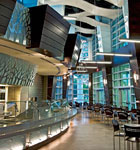The Florida Atlantic University College of Engineering Dining and Banquet Hall Facility in Boca Raton is, quite simply, delicious. It’s gorgeous, and it’s green. In fact, it’s the first LEED-CI Platinum-certified facility in Florida as well as in the State University System. “It was also the first food-service venue in the state to achieve a LEED Platinum certification, which was quite a daunting task due to the high energy and water use required by a food-service venue,” says Diana Herbert, an interior designer with Gallo Herbert Lebolo Architects (GHL).

GHL partnered with D.E.I. Food Service Equipment & Design to earn LEED Platinum for this Florida Atlantic University dining hall.
Project
Location Boca Raton, FL
Size 8,800 ft2
Completed 2011
Program Two restaurants, kitchen, and dining
and banquet halls
GHL appears to be leading the green movement in Florida, not just with this project, but with LEED-certified projects ranging from government facilities to state parks.
“Green design and practices are still relatively new, but they are catching on, especially with institutional and higher-education clients,” says Brian Herbert, who joined the firm in 1995 with firm founder William Gallo (the two were joined in 2000 by Emilio Lebolo). Adds Brian, “University students are very proactive and are demanding that these facilities be environmentally friendly and sustainable.”
Located within the four-story College of Engineering building—itself certified LEED-NC Platinum—the dining and banquet hall encompasses 8,800 square feet with two restaurants and a dining area on the first floor and a banquet hall and kitchen on the second.

Despite the riveting light fixtures above, natural light was the primary concern, which is maximized with expansive windows that make artificial light unnecessary most of the day.

The bar area within the banquet hall features Caesarstone countertops, materials with recycled content, and low-VOC paints and finishes.
Team
Architect Gallo Herbert Lebolo
Client Florida Atlantic University
Food-Service Consultant D.E.I. Food Service Equipment & Design
“GHL worked closely with D.E.I. Food Service Equipment & Design to maximize the efficiency of the food-service operations,” Brian says. More than 92 percent of the food service equipment was Energy Star rated, including Alto-Shaam food-holding cabinets, Carter Hoffman heated banquet carts, and Dean deep fryers.
A 78-percent reduction in potable water use from the calculated baseline requirements was achieved with a Hobart AM15 dishwasher and the outfitting of all faucets with water-efficient aerators by T&S Brass.
Energy is conserved in the dining and gathering areas by maximizing natural light. “Most of the time artificial lighting is not needed at all,” Brian says.
Lighting power density was reduced by more than 40 percent below the ANSI/ASHRAE 90.1 standard through the use of energy-efficient, dimmable LED and fluorescent fixtures. Daylight responsive controls by Quantum Lighting were installed near windows to minimize artificial lighting when natural lighting is plentiful. And control panels by Lutron in key locations allow manual system control.
The design team also focused heavily on the Materials and Resources and Indoor Environmental Quality categories of the LEED process. “We needed to acquire every possible point we could,” Brian says.
Products with high recycled content accounted for 12 percent of total building materials. That included metallic laminates by Chemetals with 85 percent recycled content, Armstrong Clean Room Mylar Ceilings with up to 70 percent recycled content, and Armstrong Serpentina Ceilings with 25 percent recycled content. Other recycled materials included Caesarstone countertops, porcelain tiles by Crossville, carpet by Bigelow, and Marmolium tile by Forbo.
Products with low toxin emissions included interior paints and coatings from Sherwin Williams’ Armorseal and ProGreen lines and adhesives and topping materials from ARDEX and Henry.
Green
CERTIFICATION LEED Platinum
Energy 92% of installed equipment is Energy Star-rated, daylight controls and dimmable LEDs reduce energy to 40% below baseline
Water Potable water use reduced by 78%
The project earned one point under Regional Materials by acquiring 33 percent of total building products from within a 500-mile radius, including concrete from Rinker Concrete Products and custom wood and millwork from Cayman National Manufacturing and Installation.
Following close behind the Florida Atlantic project, construction is near completion on a 24,000-square-foot processing center for Immigration & Customs Enforcement in Tallahassee, for which GHL partnered with Inovia Consulting Group. The facility is seeking LEED Silver certification with a focus on indoor air quality, high-efficiency light and mechanical systems, and preservation of the wooded location.
Gallo Herbert Lebolo, in conjunction with Nova Southeastern University and the State of Florida, has also completed the state’s first net-zero park, with a solar photovoltaic system that produces at least as much energy as the park uses. In 2008 the firm completed the state’s largest solar-heated swimming pool.

